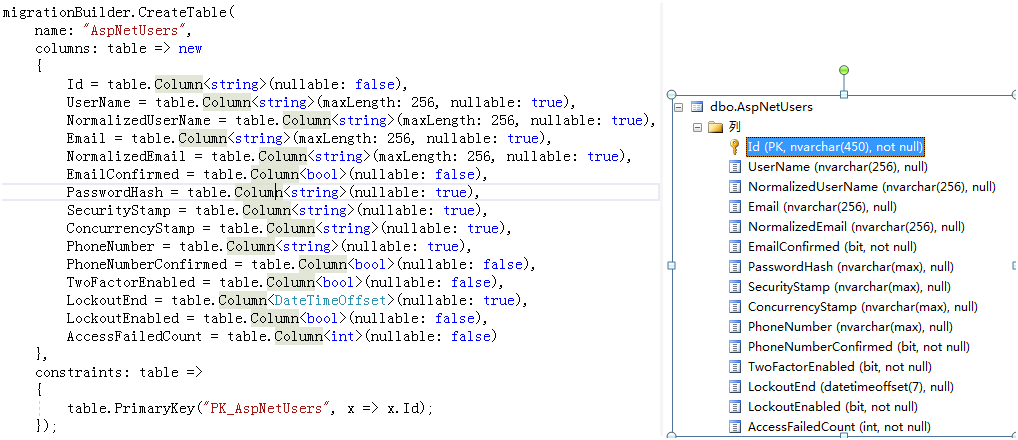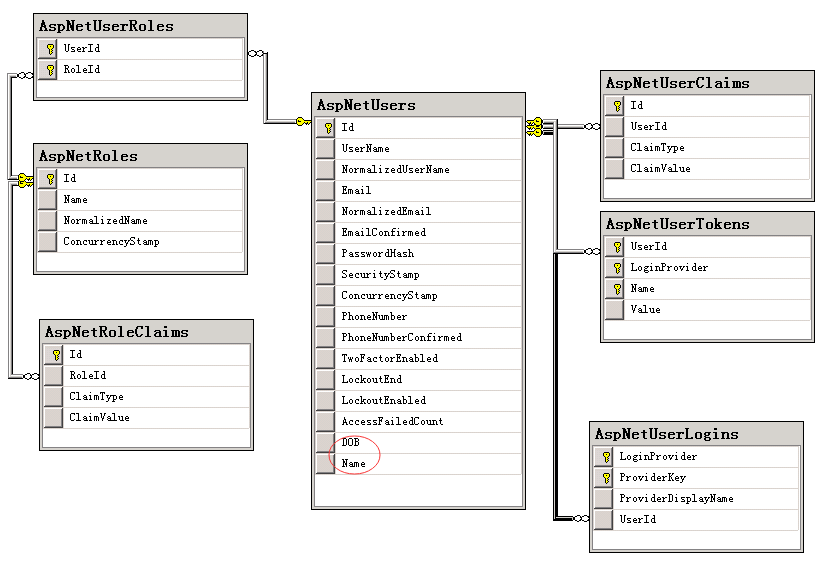一.概述
ASP.NET Core Identity提供了一个框架,用于管理和存储在 ASP.NET Core 应用中的用户帐户。 Identity添加到项目时单个用户帐户选择作为身份验证机制。 默认情况下,Identity可以使用的 Entity Framework (EF) Core 数据模型。 本文介绍如何自定义的身份标识模型。
1.1 下面是已经存在的身份模型, 由以下实体类型组成:
| 实体类型 |
说明 |
关系 |
| Users | 登录用户 | |
| Roles |
角色 |
|
| UserClaims | 用户拥有的权限 | 每个Users有多个UserClaims |
| UserTokens | 用户的身份验证令牌 | 每个Users有多个UserTokens |
| UserLogins | 将用户与登录相关联。 | 每个Users有多个UserLogins |
| RoleClaims | 角色拥有的权限 | 每个Roles有多个RoleClaims |
| UserRoles | 用户和角色关联 | 每个Users有多个Roles |
1.2 默认模型的配置
Identity定义了许多从DbContext继承以配置和使用模型的上下文类,此配置是使用上下文类的OnModelCreating方法中的EF Core Code First Fluent API完成的。默认模型结构可以查看Migration文件以及查看模型关系ModelSnapshot文件,但要修改模型不在这里更改。下面是AspNetUsers模型代码:

下面是默认模型生成的数据表以及关系:

二.模型自定义
在EF上下文中当重写OnModelCreating方法时,base.OnModelCreating方法首先调用; 接下来重写的会覆盖默认模型配置。
public class ApplicationDbContext : IdentityDbContext<WebAppIdentityDemoUser> { public ApplicationDbContext(DbContextOptions<ApplicationDbContext> options) : base(options) { } protected override void OnModelCreating(ModelBuilder builder) { base.OnModelCreating(builder); // Customize the ASP.NET Core Identity model and override the defaults if needed. // For example, you can rename the ASP.NET Core Identity table names and more. // Add your customizations after calling base.OnModelCreating(builder); } }
2.1 自定义用户数据
在上篇有讲过自定义用户数据,这里在总结下。自定义用户数据支持通过继承IdentityUser类。 自定义类命名约定 {Application}User。
//定义{Application}User扩展类,实现用户模型 public class WebAppIdentityDemoUser : IdentityUser //使用{Application}User作为上下文的泛型参数的类型: public class ApplicationDbContext : IdentityDbContext<WebAppIdentityDemoUser> //更新Startup.ConfigureServices以使用新{Application}User类,最后生成迁移,同步数据库。 services.AddDefaultIdentity<WebAppIdentityDemoUser>() .AddDefaultUI() .AddEntityFrameworkStores<ApplicationDbContext>();
2.2 更改主键类型
在创建数据库之后更改PK列的数据类型在许多数据库系统上都存在问题。更改PK通常涉及删除和重新创建表。因此,在创建数据库时,应在初始迁移中指定PK类型。下面是更改主键类型步骤:
(1) 删除数据库,命令如下:
Drop-Database
(2) 移除之前生成的迁移,命令如下:
Remove-Migration
(3) 修改user,role表主键类型,以及相关代码改动
// 用户表设置主键为Int public class WebAppIdentityDemoUser : IdentityUser<int> { /// <summary> /// Full name /// </summary> [PersonalData] public string Name { get; set; } /// <summary> /// Birth Date /// </summary> [PersonalData] public DateTime DOB { get; set; } } // 角色表设置主键为Int public class WebAppIdentityDemoRole : IdentityRole<int> { }
(4) 修改上下文
public class ApplicationDbContext : IdentityDbContext<WebAppIdentityDemoUser, WebAppIdentityDemoRole,int>
(5) 修改服务注册
services.AddIdentity<WebAppIdentityDemoUser, WebAppIdentityDemoRole>() //如果使用Identity scaffolder将Identity文件添加到项目中,请删除对该项目的调用AddDefaultUI //.AddDefaultUI() .AddEntityFrameworkStores<ApplicationDbContext>() .AddDefaultTokenProviders();
(6) 生成迁移代码,命令如下
Add-Migration IdentitySchema
(7) 同步数据库
Update-Database IdentitySchema
此时表的主键类型已修改完成,包括关系表的外键类型也同步更新了,如下图所示:

2.3 添加导航属性
导航属性仅存在于EF模型中,而不存在于数据库中,如果导航关系没有改变,模型更改不需要更新数据库。如果更改关系的模型配置可能比进行其他更改更困难。必须注意取代现有的关系。下面示例是不改变模型关系,只是在user模型上添加导航属性以及在上下文中指定关系:
public class WebAppIdentityDemoUser : IdentityUser<int> { /// <summary> /// Full name /// </summary> [PersonalData] public string Name { get; set; } /// <summary> /// Birth Date /// </summary> [PersonalData] public DateTime DOB { get; set; } //定义导航属性 public virtual ICollection<IdentityUserClaim<int>> Claims { get; set; } }
protected override void OnModelCreating(ModelBuilder builder) { base.OnModelCreating(builder); // Customize the ASP.NET Core Identity model and override the defaults if needed. // For example, you can rename the ASP.NET Core Identity table names and more. // Add your customizations after calling base.OnModelCreating(builder); builder.Entity<WebAppIdentityDemoUser>(b => { // Each User can have many UserClaims b.HasMany(e => e.Claims) .WithOne() .HasForeignKey(uc => uc.UserId) .IsRequired(); }); }
对于所有用户导航属性, 用户和角色导航属性,添加所有导航属性。参考官网文档。
2.4 更改表/列名称,字段长度(上下文中更改)
protected override void OnModelCreating(ModelBuilder builder) { base.OnModelCreating(builder); //更改表名称 builder.Entity<IdentityUser>(b => { b.ToTable("MyUsers"); }); //更改表字段名称 builder.Entity<IdentityUserClaim<string>>(b => { b.Property(e => e.ClaimType).HasColumnName("CType"); b.Property(e => e.ClaimValue).HasColumnName("CValue"); }); //更改长度 builder.Entity<IdentityUser>(b => { b.Property(u => u.UserName).HasMaxLength(128); }); }
参考文献
自定义Identity